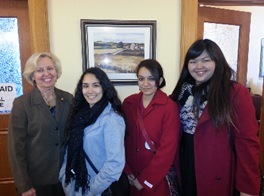
It is an honor to represent District 6 in the Kansas Senate.
If I can be of service to you, or anyone you know, please call my office at 785-296-7375, or email me at [email protected].
In this issue:
• Block grant details
• KPERS bonding
The House and Senate Leadership released their plan for a two-year block grant for K- 12 public schools. They said it would provide stability for education funding and put more money in the classrooms. That is not true. I’m writing today so you can have the details on the block grant proposal. The House Appropriations had a hearing on Monday and Senate Ways and Means will be having a hearing today. It is likely this bill will be on final action by the end of the week.
Block grant cuts funding
House and Senate leaders announced a bill to move from the current K-12 school funding formula to a block grant plan for the next two years (SB173/HB2403). During that time the legislature will develop a new funding formula. However, the bill has no sunset, so it can’t become permanent.
Here are the details of the bill:
• They claimed the bill would add $300 million to school funding by 2017. When we dug into it, we found that $129 million of the $300 million was for increases ordered by the courts and approved already last year. Most of the remaining $171 million is KPERS employer payments, which will now be taken from the block grants. No “new” money for schools- and some of the $129 million is going away.
• They plan to allow transferring of monies between funds. Some funds will still be restricted, like bond and interest funds and special education. The problem is that monies used now to provide specific services (like programs for at-risk students, bi-lingual students or technical education students) will now likely have to be used to just keep the doors open and lights on. This could mean the end of all day kindergarten and 4 year old at-risk preschool, just to name a couple of things.
• There is nothing in the block grants to automatically allow for growth in student population. Schools with extraordinary growth can apply separately for some money from an Extraordinary Need Fund, to be determined by a legislative group. Nearly $30 million in current funding is taken from school districts for this fund.
• The bill restores the $28 million the Governor just cut from base state aid in his February allotments. However, it cuts $51 million from LOB equalization and capital outlay aid. So in effect, the school districts now have a larger cut to deal with before June 30, and have to cut in different accounts than they were told last month. Low-property value districts were hurt the worst with this new LOB-capital outlay formula. The richest districts got more money.
• If the state reduces what your district gets for LOB aid going forward, it can be recovered by raising local property taxes. Some districts can cover that kind of loss with reserve funds to get through June 30. All districts in our area are getting an LOB aid cut. If reserve funds are used to cover the cuts this year, there will likely be property tax increases next year to keep afloat.
• There will be a change to calculating aid for bond and interest aid after July 1. Current bonds are not impacted. However, in the past the state provided help to furnish new buildings and that is gone.
The governor says the current formula is too complex and doesn’t have enough flexibility or certainty. In my opinion, the current formula is fine. The uncertainty has come about because the legislature has failed to fund the formula for a number of years.
The bottom line is the block grant forces local school districts to raise taxes to keep the same funding they have today. It’s a tax shift to property taxes. It is dis-equalizing, punishing poor districts the most. And it is likely unconstitutional. They put this bill on the fast track.
One of the most worrisome parts of the block grant parts of the block grant proposal is that it hurts the districts with low property value districts. The LOB aid and capital outlay aid are aimed at equalizing property values across the state and those funds are getting the biggest cuts. The Topeka Capital-Journal reported that 80% of the poorest districts would lose equalization money while 90% of the richest districts gain funding. The courts ordered the legislature to pay the equalization money- so kids in every Kansas zip code could get a good education. The block grant proposal flies in the face of the court order and the Kansas Constitution.
Update: House Appropriations did amend the school finance bill into Senate Bill 7. The only place this bill will be worked is on the House floor. This is called “gut and go” and is totally against the process.
Alexis Her, Briana Soto and Sandra Velasquez, students from Turner High School, joined me here at the Capitol as Senate Pages on March 5.
KPERS borrowing
The Senate passed SB168 last week to bond $1.5 billion to shore up the KPERS fund. With the shortfall in revenues, the state cannot make its employer payment to the fund. The idea is to sell bonds at a rate below 5%, then take the money and invest it and make a profit. Historically, KPERS funds have earned about 8%. The profit would make the KPERS employer payments.
Financial experts are raising red flags about this approach. They are saying that jumping into the market when it is at a all-time high is not a good strategy. The debt service on the $1.5 billion would be about $90 million, and we would owe that whether we made a profit on the bond money or not. The Government Finance Officers Association recommended that such deals be avoided as they are too risky.
I am pictured with winners of kchealthy kids “I Am Here” youth photo contest at the awards ceremony held earlier this week. They are Antonio Droge and his 8th grade class at Rosedale Middle School.
Kansas State Board of Education member Janet Waugh with me at the Kansas Democratic Party’s Washington Days last weekend.



